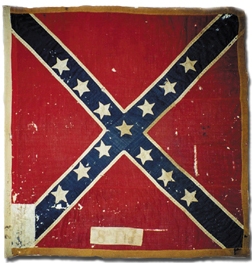The 50th Georgia Infantry Regiment was an infantry regiment raised by the state of Georgia to fight for the Confederacy in the American Civil War.
The 14th Indiana Infantry Regiment, later referred to as the Gallant Fourteenth, was an infantry regiment and part of the Union Army's celebrated "Gibraltar Brigade" of the Army of the Potomac during the American Civil War. Organized in May 1861 at Camp Vigo, near Terre Haute, Indiana, it was the state's first regiment organized for three years of service. The 14th Indiana served in major campaigns and battles in the Eastern Theater, mostly in West Virginia, Virginia, Pennsylvania, and Maryland. During its three years of service, the regiment had a total of 222 casualties.
The 51st Georgia Infantry Regiment was an infantry regiment in the Confederate States Army during the American Civil War.

Florida participated in the American Civil War as a member of the Confederate States of America. It had been admitted to the United States as a slave state in 1845. In January 1861, Florida became the third Southern state to secede from the Union after the November 1860 presidential election victory of Abraham Lincoln. It was one of the initial seven slave states which formed the Confederacy on February 8, 1861, in advance of the American Civil War.

The Texas Brigade was an infantry formation of the Confederate Army that distinguished itself in the American Civil War. Along with the Stonewall Brigade, they were considered the Confederate Army's shock troops. It fought in every major battle of the Eastern Theater except Chancellorsville.

The Iron Brigade, also known as The Black Hats, Black Hat Brigade, Iron Brigade of the West, and originally King's Wisconsin Brigade was an infantry brigade in the Union Army of the Potomac during the American Civil War. Although it fought entirely in the Eastern Theater, it was composed of regiments from three Western states that are now within the region of the Midwest. Noted for its strong discipline, its unique uniform appearance and its tenacious fighting ability, the Iron Brigade suffered the highest percentage of casualties of any brigade in the war.
The 24th Georgia Infantry Regiment was an infantry regiment in the Confederate States Army during the American Civil War. The regiment was part of Thomas Cobb's brigade at the Battle of Fredericksburg.

The 18th Georgia Infantry Regiment was an infantry regiment in the Confederate Army during the American Civil War. Originally brigaded with the three Texas regiments of John Bell Hood's Texas Brigade, it was transferred to Thomas R.R. Cobb's Georgia Brigade after the Battle of Antietam in late 1862. After General Cobb was mortally wounded at the Battle of Fredericksburg, the original colonel of the 18th Georgia, William T. Wofford, became Brigadier General of the Georgia Brigade.

The 2nd Florida Infantry Regiment was an infantry regiment that fought in service of the Confederate States Army in the American Civil War.

The 66th Ohio Infantry Regiment was an infantry regiment in the Union Army during the American Civil War. It was noted for its holding the high ground at the center of the line at Antietam as part of Tyndale's 1st Brigade, Greene's 2nd Division of Mansfield's XII Corps.

The 13th Regiment Massachusetts Volunteer Infantry was an infantry regiment in the Union Army during the American Civil War. It was formed on July 16, 1861, at Fort Independence in Boston, Massachusetts. Its original commander was Colonel Samuel H. Leonard.

The 5th Florida Infantry Regiment served in E.A. Perry's Florida Brigade alongside the 2nd and 8th Florida. Perry's Brigade served under Anderson’s Division of Longstreet’s First Corps, of the Army of Northern Virginia.

The 8th Florida Infantry Regiment was a unit of the Confederate States Army during the American Civil War. Serving in the Army of Northern Virginia throughout the war; it fought in most battles of the Eastern Theater.

The 3rd Alabama Infantry Regiment was an infantry regiment that served in the Confederate Army during the American Civil War. The 3rd Alabama consisted mainly of men from the Alabama counties of Autauga, Coosa, Lowndes, Macon, Mobile and Montgomery.

The 6th Louisiana Infantry Regiment served in the Confederate States Army during the American Civil War. It was part of the Louisiana Tigers. Formed in June 1861 at Camp Moore, it fought in Jackson's Valley campaign, the Battle of Gaines Mill, the Second Battle of Bull Run and its related actions, and the Battle of Antietam in 1862. The next year, it fought at the Second Battle of Fredericksburg, the Battle of Salem Church, the Second Battle of Winchester, and the Battle of Gettysburg before being overrun at the Second Battle of Rappahannock Station. It spent 1864 fighting in Grant's Overland campaign and with Jubal Early in the Valley campaigns of 1864. The regiment fought in the Battle of Hatcher's Run and the Battle of Fort Stedman in early 1865 before surrendering after the Battle of Appomattox Court House in April. It began its service with 916 men and ended with 52.

The 8th Louisiana Infantry Regiment was a unit of volunteers recruited in Louisiana that fought in the Confederate States Army during the American Civil War. Formed in June 1861, the regiment was sent to fight in the Eastern Theater of the American Civil War. Joining a brigade of Louisiana regiments, it fought in Jackson's Valley campaign and at Gaines' Mill, Malvern Hill, Second Bull Run, Antietam, and Fredericksburg in 1862. The regiment served at Chancellorsville, Second Winchester, Gettysburg in 1863. At Rappahannock Station in November 1863, most of the regiment was captured. The unit fought at the Wilderness, Spotsylvania, Cold Harbor, and the Valley campaigns of 1864. It served at Petersburg starting in December 1864 and surrendered at Appomattox in April 1865.

The 7th Louisiana Infantry Regiment was a unit of volunteers recruited in Louisiana that fought in the Confederate States Army during the American Civil War. Formed in June 1861, the regiment was sent to fight in the Eastern Theater of the American Civil War. After fighting at First Bull Run, the unit joined the 1st Louisiana Brigade. The regiment served in Jackson's Valley campaign and at Gaines' Mill, Malvern Hill, Cedar Mountain, Second Bull Run, Harpers Ferry, Antietam, and Fredericksburg in 1862. The regiment fought at Chancellorsville, Second Winchester, and Gettysburg in 1863. At Rappahannock Station in November 1863, almost the entire regiment was captured. The remnant of the unit fought at the Wilderness, Spotsylvania, Cold Harbor, and the Valley campaigns of 1864. It served at Petersburg starting in December 1864 and surrendered at Appomattox in April 1865.
The 5th Louisiana Infantry Regiment was a unit of volunteers recruited in Louisiana that fought in the Confederate States Army during the American Civil War. Formed in June 1861, the regiment was sent to fight in the Eastern Theater of the American Civil War. The regiment served at Yorktown, White Oak Swamp, Cedar Mountain, Second Bull Run, Harpers Ferry, Antietam, and Fredericksburg in 1862. The regiment fought at Chancellorsville, Second Winchester, and Gettysburg in 1863. At Rappahannock Station in November 1863, virtually the whole regiment was captured. The unit's remnant fought at the Wilderness, Spotsylvania, Cold Harbor, and the Valley campaigns of 1864. It served at Petersburg starting in December 1864 and a mere handful surrendered at Appomattox in April 1865.

The 14th Louisiana Infantry Regiment was a unit of volunteers recruited in Louisiana that fought in the Confederate States Army during the American Civil War. Formed in June 1861 as the 1st Regiment, Polish Brigade, the unit was later accepted into Confederate service as the 13th Regiment. After being sent to fight in the Eastern Theater of the American Civil War, it was renamed the 14th Regiment. In 1862, it fought at Yorktown, Williamsburg, Seven Pines, Beaver Dam Creek, Gaines' Mill and Glendale. At Glendale, the unit suffered a severe number of casualties and, thereafter, surviving members of the regiment dubbed the battle "the Slaughterhouse."

The 15th Louisiana Infantry Regiment was a unit of volunteers recruited in Louisiana that fought in the Confederate States Army during the American Civil War. Formed in June 1861 as the 2nd Regiment, Polish Brigade, the unit was sent to fight in the Eastern Theater of the American Civil War. As the 3rd Louisiana Infantry Battalion, the unit served at Beaver Dam Creek and Glendale. After two companies from the 7th Louisiana Infantry Battalion were added in July 1862, the unit reorganized as the 15th Louisiana Infantry Regiment. It joined the 2nd Louisiana Brigade and fought at Cedar Mountain, Second Bull Run, Antietam, and Fredericksburg in 1862. It served at Chancellorsville, Second Winchester, Gettysburg, and Mine Run in 1863. The regiment fought at the Wilderness, Spotsylvania, Cold Harbor, Monocacy, Third Winchester, Fisher's Hill, Cedar Creek, and Petersburg in 1864. A handful of survivors surrendered at Appomattox in 1865.
















